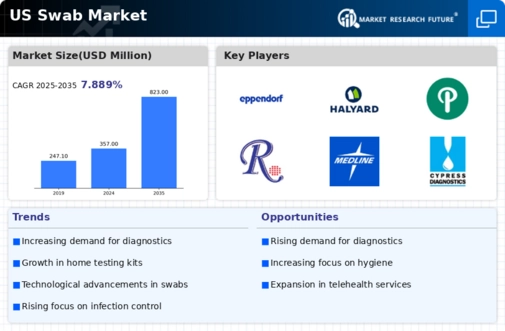Rising Demand for Diagnostic Testing
The swab market in the US is experiencing a notable increase in demand for diagnostic testing. This surge is primarily driven by the growing prevalence of infectious diseases and the need for rapid testing solutions. According to recent data, the market is projected to grow at a CAGR of approximately 8% over the next five years. The swab market is adapting to this demand by innovating and expanding product lines to include various types of swabs suitable for different testing methods. This trend indicates a shift towards more efficient and accurate diagnostic tools, which is likely to enhance patient outcomes and streamline healthcare processes.
Expansion of Healthcare Infrastructure
The expansion of healthcare infrastructure in the US is significantly impacting the swab market. As hospitals and clinics increase their capacity and capabilities, the demand for swabs is expected to rise correspondingly. Recent reports suggest that healthcare spending in the US is projected to reach $4 trillion by 2025, which will likely include investments in diagnostic tools and equipment. This growth in infrastructure not only facilitates better access to healthcare services but also drives the need for high-quality swabs in various medical settings. Consequently, the swab market is poised to benefit from this expansion, as healthcare providers seek reliable and efficient testing solutions.
Technological Integration in Healthcare
The integration of advanced technologies in healthcare is reshaping the swab market. Innovations such as automation, artificial intelligence, and telemedicine are enhancing the efficiency of diagnostic processes. For instance, automated swab collection systems are being developed to minimize human error and improve sample integrity. The swab market is likely to see increased investment in these technologies, as healthcare providers aim to streamline operations and improve patient care. This technological evolution may also lead to the development of new swab types that are compatible with digital health solutions, further expanding the market's potential.
Regulatory Support for Innovative Products
Regulatory support for innovative healthcare products is playing a crucial role in the swab market. The US Food and Drug Administration (FDA) has been actively working to expedite the approval process for new diagnostic tools, including swabs. This regulatory environment encourages manufacturers to invest in research and development, leading to the introduction of advanced swab technologies. The swab market is likely to benefit from this supportive framework, as it fosters innovation and ensures that high-quality products reach the market more quickly. As a result, consumers may gain access to more effective testing solutions, enhancing overall public health outcomes.
Increased Awareness of Preventive Healthcare
There is a growing awareness of preventive healthcare among the US population, which is influencing the swab market. As individuals become more proactive about their health, the demand for regular testing and screening is likely to increase. This trend is supported by initiatives aimed at promoting health education and preventive measures. The swab market is responding by developing swabs that cater to a wider range of testing needs, including at-home testing kits. This shift towards preventive healthcare could potentially lead to a more informed public, ultimately driving growth in the swab market as consumers seek convenient and accessible testing options.






















Leave a Comment